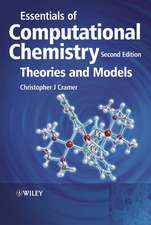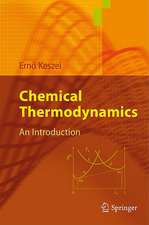Conceptual Perspectives in Quantum Chemistry
Editat de Jean-Louis Calais, Eugene S. Kryachkoen Limba Engleză Paperback – 16 oct 2012
| Toate formatele și edițiile | Preț | Express |
|---|---|---|
| Paperback (1) | 403.91 lei 43-57 zile | |
| SPRINGER NETHERLANDS – 16 oct 2012 | 403.91 lei 43-57 zile | |
| Hardback (1) | 598.32 lei 43-57 zile | |
| Kluwer Academic Publishers – 30 aug 1997 | 598.32 lei 43-57 zile |
Preț: 403.91 lei
Nou
Puncte Express: 606
Preț estimativ în valută:
77.31€ • 84.01$ • 64.98£
77.31€ • 84.01$ • 64.98£
Carte tipărită la comandă
Livrare economică 21 aprilie-05 mai
Preluare comenzi: 021 569.72.76
Specificații
ISBN-13: 9789401063487
ISBN-10: 9401063486
Pagini: 572
Ilustrații: XVI, 553 p.
Dimensiuni: 160 x 240 x 30 mm
Greutate: 0.79 kg
Ediția:Softcover reprint of the original 1st ed. 1997
Editura: SPRINGER NETHERLANDS
Colecția Springer
Locul publicării:Dordrecht, Netherlands
ISBN-10: 9401063486
Pagini: 572
Ilustrații: XVI, 553 p.
Dimensiuni: 160 x 240 x 30 mm
Greutate: 0.79 kg
Ediția:Softcover reprint of the original 1st ed. 1997
Editura: SPRINGER NETHERLANDS
Colecția Springer
Locul publicării:Dordrecht, Netherlands
Public țintă
ResearchCuprins
Recent Developments In Multiple Scattering Theory And Density Functional Theory For Molecules And Solids.- 1. Introduction.- 2. Multiple Scattering Theory.- 3. Variational Principles.- 4. Wave Functions at Cell Boundaries.- 5. Green Functions.- 6. Computational Theory.- 7. Density Functional Theory.- Acknowledgments.- References.- Localized Atomic Hybrids: A General Theory.- 1. Introduction.- 2. Use of Symmetry.- 3. Basis Space.- 4. Sample Space.- 5. Alias Functions.- 6. Example of Hybrids.- 7. Localization.- 8. Several Equivalent Sets.- 9. Quadrature.- 10.Calculation of Molecular Properties.- References.- Quantum Electrodynamics And Molecular Structure Molecular Electrodynamics.- 1. Introduction.- 2. Quantum Mechanics of the Spectroscopic Experiment.- 3. The Electrodynamics of Molecules.- 4. Electron-Molecule Scattering.- 5. Photon-Molecule Scattering; the Kramers-Heisenberg Formula.- 6. Discussion.- 7. References.- Aspects Of The Chemical Bond 1996.- 1. Introduction.- 2. Ionic Materials.- 3. Application of an Alternative Approach to Inorganic Structures.- 4. Mechanisms of Reactions.- 5. Conclusion.- References.- Lie Symmetries In Quantum Mechanics.- 1. Introduction.- 2. Lie Symmetries.- 3. Solutions to the Time-Dependent Schrödinger Equation.- 4. Coherent States.- 5. Examples.- 6. Transformation of the Schrödinger Equation.- Acknowledgement.- Appendix I.- References.- The Interplay Between Quantum Chemistry And Molecular Dynamics Simulations.- 1. Introduction.- 2. Molecular Dynamics Simulations.- 3. Aspects of Parametrization.- 4. Conclusions.- 5. Acknowledgements.- 6. References.- The Permutation Group In Many-Electron Theory.- 1. Introduction.- 2. The Electronic Schrödinger Equation.- 3. Approximate N-Electron Functions.- 4. Concluding Remarks.- 5.Acknowledgment.- References.- New Developments In Many Body Perturbation Theory And Coupled Cluster Theory.- 1. Introduction.- 2. Møller-Plesset Perturbation Theory.- 3. Møller-Plesset Perturbation Theory at Sixth Order.- 4. Coupled Cluster Theory.- 5. Analysis of Coupled Cluster Methods in Terms of Perturbation Theory.- 6. Coupled Cluster Methods with Triple Excitations.- 7. Conclusions and Outlook.- 8. Acknowledgements.- 9. References.- A Philosopher’s Perspective On The “Problem” Of Molecular Shape.- 1. Introduction.- 2. A Physical Account of Shape.- 3. Interlude: Exactly Which Concept of Shape is Being Challenged?.- 4. Reduction and Explanation.- 5. Realism, Physicalism and Materialism.- 6. Conclusion.- Acknowledgements.- Endnotes.- References.- Van Der Waals Interactions From Density Functional Theories: The He-CO System As A Case Study.- 1. Introduction.- 2. An Outline of Interaction Contributions.- 3. The Density Functional Approach.- 4. An Overview of Earlier Studies on the He-CO Interaction.- 5. DFT Calculations of the Interaction.- 6. Summary and Conclusions.- 7. Acknowledgements.- References.- Different Legacies and Common Aims: Robert Mulliken, Linus Pauling And The Origins Of Quantum Chemistry.- I.- II.- Notes.- Potential Energy Hypersurfaces For Hydrogen Bonded Clusters (HF) N.- 1. Introduction.- 2. Sampling and Representation Methodology.- 3. Approximations in ab Initio Electronic Structure Theory.- 4. Potentials.- 5. Clusters.- 6. Conclusions and Outlook.- Acknowledgement.- References.- One-Electron Pictures Of Electronic Structure: Propagator Calculations On Photoelectron Spectra Of Aromatic Molecules.- 1. Introduction.- 2. The Electron Propagator.- 3. The Uncorrelated Case.- 4. Superoperator Theory.- 5. Projection and Partitioning Techniques.-6. Relationships to Hilbert Space Theories.- 7. The Dyson Equation.- 8. Perturbative Self-Energies.- 9. Quasiparticle Methods.- 10.Computational Techniques.- 11.Interpretations of Photoelectron Spectra.- 12.Conclusions.- 13.Acknowledgments.- References.- Shape in Quantum Chemistry.- 1. Introduction.- 2. Molecular Shape: The Shape Group Methods.- 3. The Shape of Potential Energy Hypersurfaces: The Fundamental Group of Reaction Mechanisms.- 4. An Analogy Between Shape Groups and The Fundamental Groups of Reaction Mechanisms.- Summary.- References.
Recenzii
`The book is recommended to researchers and graduate students in theoretical, computational, structural, and solid state chemistry.'
Structural Chemistry, 10:2 (1999)
Structural Chemistry, 10:2 (1999)












